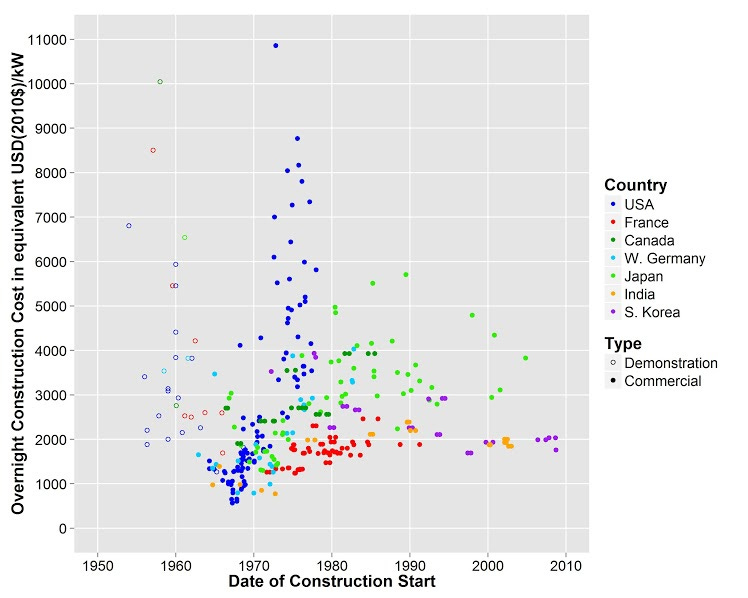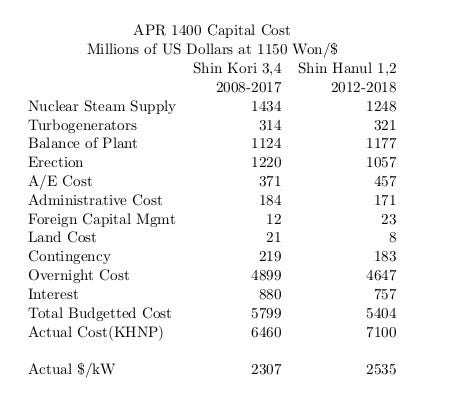Nuclear is too Expensive
Nuclear is Too Costly
A valid argument against nuclear power is that it is too expensive. You bet it is; in some cases five or more times too expensive.
Nuclear power emerged at just about the most difficult time possible economically. In the early-mid 1960's, the real cost of oil was at a all time low. The majors were buying oil in the Middle East at about a penny a liter. Oil was so cheap that it was pushing into electricity generation, the long time preserve of coal. This in turn forced the price of coal down, so it too was at an all time low. This was the cutthroat market that a technology that did not exist 15 years earlier, a technology that was just starting down a steep learning curve, had to enter and compete in. Amazingly it did so. Thanks to nuclear's incredible energy density, these fledgling plants were able to produce electricity at 0.37 cents per kWh in 1965. That's less than 3 cents/kWh in 2020 money. Overnight capital costs were less than $1000/kW in 2020 dollars, Figure 1
Figure 1 Nuclear Overnight Costs from Lovering et al. Multiply by 1.2 to get 2020 USD
But the cost of nuclear power escalated rapidly. The Oil Crisis created a bonanza for coal and nuclear. In the boom of the early 70's, nuclear lost control of its costs, as did coal. This was accompanied by regulatory attempts to ensure we would never have a release of radioactive material. These attempts led to ALARA, the regulatory principle that any exposure to radiation is unacceptable if the plant can afford to reduce it further. In other words, there are no limits. And the criterion is not whether the benefits of the reduction, if any, outweigh the costs. The criterion is: can the plant afford it? ALARA mandated the regulator to force the cost of nuclear power at least up to the cost of its competitors. ALARA quickly priced nuclear out of business. In the USA, new nuclear plant ordering dried up in 1975. This was four years before Three Mile Island, and a time during which nuclear power enjoyed strong public support.
After the boom ended, coal costs fell back to pre-boom levels in real terms. But nuclear's prohibitively expensive regulation could not be rescinded. The regulatory ratchet only works in one direction. US nuclear was stuck with top of the boom costs. Vogtle 3 and 4 will cost more than $10,000/kW.
Outside the USA, there was more push back against this regulatory philosophy. The French utility, EDF, was given complete control of the project. It was essentially a form of self-regulation. France started out at around $1400/kW and was able to hold her overnight cost below $2000 per kilowatt through 1980. She largely decarbonized her grid in the 1970's.
More recently, the Koreans were able to achieve overnight costs of $2000/kW domestically, Table 1. The Chinese appear to be approaching that number. Thanks to nuclear's 500,000:1 advantage in energy density, a nuclear plant requires about 1/3 the steel and less concrete than a coal plant of the same capacity. Even under current prohibitive US regulatory policy, the material requirements are less than those of a coal plant. Yet a top of the line coal plant will cost about $1500/kW.
Table 1 APR 1400 CAPEX including construction interest.
When we build a nuclear plant, we give an omnipotent regulator monopoly control over the project. The regulator sees no benefit from the low CO2, near zero pollution electricity produced by the plant, but he owns any problems. To escape that responsibility, he relies on rigid procedures and voluminous paperwork, which documents that all procedures have been followed religiously. So whatever happens, it's not his fault. By stifling technical progress, squashing competition, demoralizing workers, diverting management, and diluting responsibility, this perverse set of incentives often results in shoddy quality. The solution to the resulting problems and screw ups is still more rigidly proscribed procedures, more detailed paperwork, more time consuming sign offs and approvals, and the downward spiral continues.
Such a system always results in additional costs and delays. If unchecked, those costs explode and the delays become interminable, as happened at Vogtle and elsewhere. This is not a problem for the regulator; and it's his incentives that control the project.
When we asked a group of Indonesian nuclear regulators to balance nuclear versus coal, one of them had the honesty to stand up and say ``I don't care what the problems with coal are. I'm a nuclear regulator. My job is to make nuclear power as safe as possible". Recently the Japanese prime minister called for rapid start up of the plants shut down after Fukushima to avoid a crisis this winter. The head of the Japanese regulatory agency responded that this was not going to happen. His view is ``Our goal as a regulator is to not be influenced by an ongoing debate on whether or not to use nuclear." In other words, we ignore the benefit side and we are in charge.
The Holy Grail of regulation of hazardous, beneficial activities is to find the sweet spot, the right balance between hazard and benefit. But we have set up a system in which the regulator focuses only on the hazard.
The mortality associated with a terrawatt-hour of coal is several hundred times higher than that for a TWh of nuke, Figure 2. Yet we are content to rely on the investor's self interest to produce a robust, reliable coal plant. We let the operator know society's requirements with respect to pollution and safety and inform him the plant will be monitored and fined or shut down if he violates those requirements. That's it.
/nfs/TC/gordian/figs/deaths_p_TWh.png}
Figure 2 Deaths per TWh by source.
Radiation health hazards aside, due to the difficulty of repair, the economic cost of a nuclear plant failure is almost always far higher than the cost of a similar coal plant mishap. We just have to make sure the investor/operator bears that billion plus dollar cost, and he will build a robust plant and operate it prudently. We do not need to tell him how.
Imagine what would happen if we regulated nuclear like we regulate coal. Competition would force nuclear costs down to less than $2000/kW and then keep pushing those costs down. The power would cost 3 cents/kWh or less. Coal could not compete. Gas would be relegated to a bit of peaking. Wind and solar could not compete except in a few niche markets, avoiding a debilitating drain on the planet's precious resources. The electrical grid would decarbonize automatically and efficiently.
The process would be scalable. The grid could easily expand to handle electric vehicles and building heating. Low carbon ammonia for fertilizer becomes feasible. With the help of a tolerable CO2 tax, hydrogen based synfuels become possible
But we will have releases of radioactive material you cry. Yes, we will; and we have. We have had three highly publicized releases from commercial nuclear plants. At Three Mile Island, the average dose in the area was equivalent to a one-way flight from New York to Los Angles. One member of the public may have received a dose equivalent to 10 round trip cross country flights. At Fukushima, a 200,000 times larger release, the harm to the public from radiation, if any, will be statistically undetectable.
Chernobyl was bad. At Chernobyl, approximately 50 people were killed, most within a month. We expect some increased cancer incidence; but aside from the liquidators we haven't seen any. (Liquidators were conscripts brought in to clean up the mess.) 30 years on, Harvard Medical School found that cancer incidence in the districts closest to the plant is not statistically different from the rest of Ukraine. There has been a modest increase in liquidator cancer incidence. Some of the liquidators received doses far higher than the worst public dose and much worse they received that dose over a very short period, in some cases minutes. But liquidator cancer mortality is lower than the control group, presumably because of earlier detection and better treatment.
Under worst case assumptions, the total mortality associated with Chernobyl from radiation is equivalent to about 200 aircraft fatalities. Since 1960, we have had 22 crashes that killed at least this many people. We tolerate those crashes in return for the benefits of air travel. The benefits of nuclear power are immeasurably greater than the benefits of air travel. Among those benefits are a reduction in the mortality that would have been caused by alternative power sources. In most scenarios, nuclear will save many more lives than it takes. An occasional release is not only tolerable, it is societally optimal.
Don't get me wrong. I'm no more in favor of radioactive releases than I am in favor of aircraft crashes. But the planet will be a far better place with cheap nuclear power and an occasional release than without both.





How we get there is one question. Whether or not economic/political interests will "allow it" is another question, but right now is a sweet spot for progress. An old tech, CANDU, is safe and burns unenriched fuel. Other reactors burn 90%+ of their fuel. Mining. OK. Hmm. "in situ" leaching has cut down on air and water pollution. What if we used breeder reactors? Mine less. Burn safer. Dispose of less. Going to be interesting.
So the big question is how do we get there?